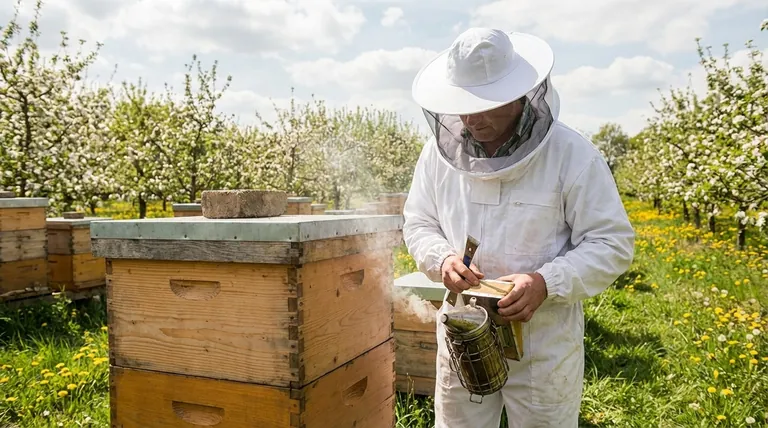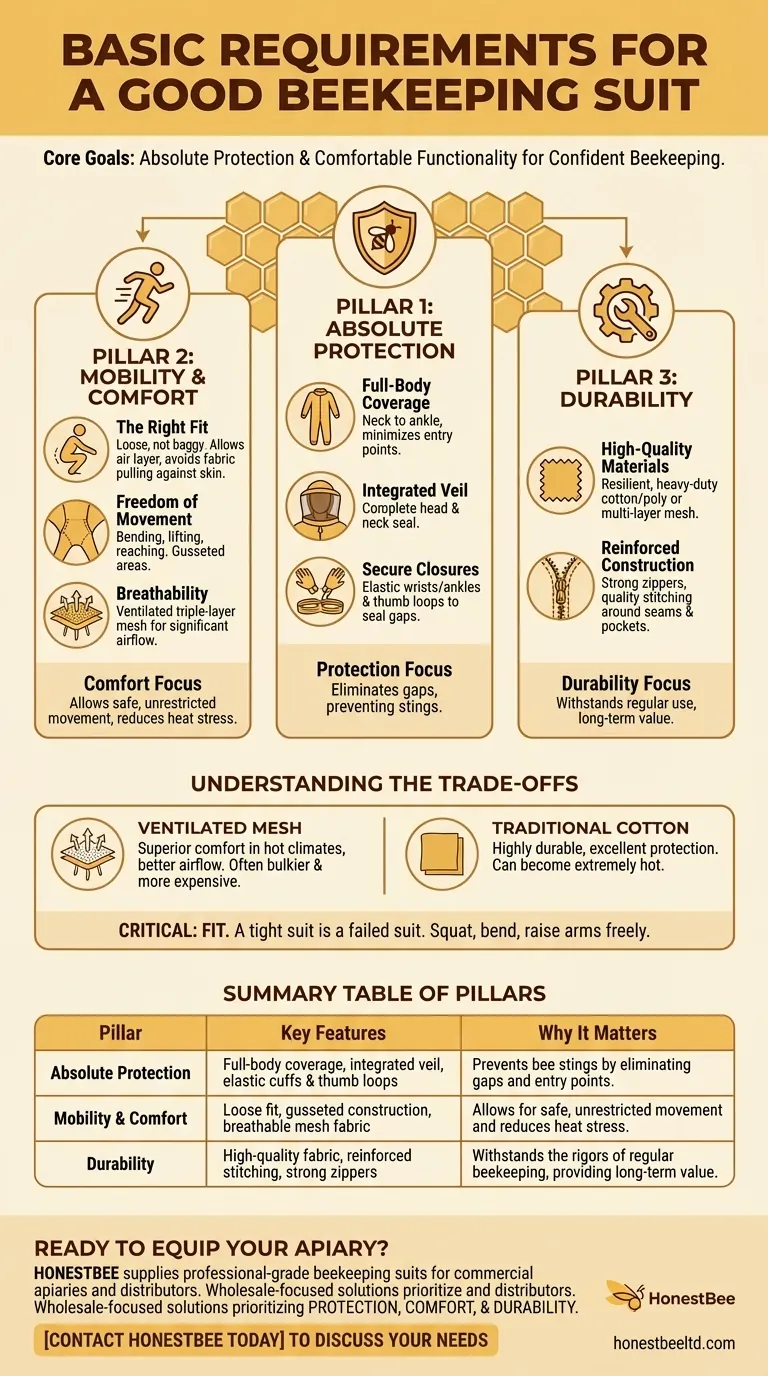At its core, a good beekeeping suit must achieve two primary goals: it must provide absolute protection from stings, and it must be comfortable and functional enough that it doesn't hinder your work. The best suits are a carefully engineered balance of impenetrable defense, full mobility, and long-term durability, allowing you to focus on your bees with confidence.
The purpose of a quality beekeeping suit is not just to prevent stings, but to empower you to be a calmer, more effective beekeeper. It is an investment in safety and focus, removing the fear of being stung so you can properly tend to your hives.

The Pillars of an Effective Bee Suit
A truly effective suit is built on three foundational principles: protection, mobility, and durability. Excelling in one area at the expense of another results in a compromised tool.
Pillar 1: Absolute Protection
This is the suit's primary function. Key features are non-negotiable for ensuring bees cannot reach your skin.
Full-Body Coverage The suit must be a one-piece overall that covers you from your neck to your ankles. This minimizes potential entry points that could exist with separate jackets and pants.
Integrated Veil A high-quality suit includes an integrated veil that zips directly onto the suit's collar. This creates a complete seal around your head and neck, one of the most common targets for defensive bees.
Secure Closures Look for strong elastic bands at the ankles and wrists. These are critical for creating a tight seal over your boots and gloves, which are the most common entry points for determined bees. Thumb ties or loops are an excellent feature that keeps sleeves from riding up when you put on your gloves.
Pillar 2: Mobility and Comfort
A suit that restricts your movement is not only frustrating but also unsafe, as it can lead to fatigue or fumbling.
The Right Fit Your suit should be loose-fitting but not excessively baggy. A suit that is too tight pulls the fabric against your skin, reducing its protective gap and making it easier for a bee's stinger to penetrate. A proper fit allows for a layer of air between you and the fabric.
Freedom of Movement Quality suits are designed for the physical work of beekeeping. They allow for easy bending, lifting, and reaching. This is often achieved with gusseted construction in high-mobility areas like the crotch and under the arms.
Breathability Working in an apiary can be hot. Modern suits often use ventilated or aerated mesh fabric (such as triple-layer mesh) that allows for significant airflow while maintaining a protective thickness that bee stingers cannot bridge.
Pillar 3: Durability
A beekeeping suit is a piece of working equipment that must withstand regular use and potential snags.
High-Quality Materials The fabric must be resilient to tearing. Whether it's a heavy-duty cotton/poly blend or a multi-layer synthetic mesh, the material should feel substantial.
Reinforced Construction Check for strong zippers, as they are a frequent point of failure. The quality of the stitching, especially around seams and pockets, is a key indicator of how long the suit will last.
Understanding the Trade-offs
Choosing a suit involves balancing different factors. There is no single "best" suit, only the best suit for your climate and work style.
Ventilated Mesh vs. Traditional Cotton
Ventilated suits offer superior comfort in hot climates by allowing air to flow freely, but they are often bulkier and more expensive.
Traditional cotton or poly-cotton suits are highly durable and offer excellent protection, but they can become extremely hot during summer inspections.
The Critical Importance of Fit
It cannot be overstated: a tight suit is a failed suit. When you try on a suit, you should be able to squat, bend over, and raise your arms above your head without the fabric pulling taut against your shoulders, back, or knees. A loose fit is a core part of the protective system.
Veil Design
While not a suit feature, the veil type (round vs. fencing style) is a key part of the system. Fencing veils offer a wider field of view, while round veils keep the mesh further from your face on all sides. This is largely a matter of personal preference.
Making the Right Choice for Your Goal
Select your gear based on your specific beekeeping needs.
- If your primary focus is occasional hobby beekeeping: A durable poly-cotton suit with strong elastic closures and an integrated veil offers a great balance of protection and value.
- If your primary focus is working in a hot climate: Investing in a fully ventilated, triple-layer mesh suit will dramatically improve your comfort and allow you to work longer and more safely.
- If your primary focus is maximum safety and confidence: Choose a high-quality ventilated suit with overlapping zippers, thumb loops, and elasticized ankle and wrist cuffs to ensure no gaps in your protection.
Ultimately, your bee suit is your most important piece of personal protective equipment, enabling you to work with calm and focused attention.
Summary Table:
| Pillar | Key Features | Why It Matters |
|---|---|---|
| Absolute Protection | Full-body coverage, integrated veil, elastic cuffs & thumb loops | Prevents bee stings by eliminating gaps and entry points. |
| Mobility & Comfort | Loose fit, gusseted construction, breathable mesh fabric | Allows for safe, unrestricted movement and reduces heat stress. |
| Durability | High-quality fabric, reinforced stitching, strong zippers | Withstands the rigors of regular beekeeping, providing long-term value. |
Ready to Equip Your Apiary with Confidence?
Your bee suit is your first line of defense, enabling you to work calmly and effectively. HONESTBEE supplies professional-grade beekeeping suits and equipment designed for the demands of commercial apiaries and distributors.
We provide wholesale-focused solutions that prioritize the protection, comfort, and durability your operation depends on.
Contact HONESTBEE today to discuss your needs and discover how our equipment can enhance the safety and efficiency of your beekeeping business.
Visual Guide

Related Products
- Cotton Beekeeping Suit and Round Hat with Veil Bee Keeper Protective Gear
- White Beekeeping Protective Suit and Hat with Fencing Veil for Beekeepers
- Heavy Duty Cowboy Beekeeper Hat with Visibility Veil Outdoor Professional Beekeeping Protective Gear
- Beekeeper Cowboy Hat and Veil for Beekeeping
- Beekeeping Gloves Goatskin Leather with Long Cotton Sleeve for Beekeepers
People Also Ask
- How should a bee suit be cleaned? Protect Your Investment and Ensure Apiary Safety
- What are the benefits of a fully ventilated beekeeping suit? Stay Cool and Protected in Hot Climates
- What should be considered regarding the color of beekeeping clothing? Ensure Your Safety and Keep Bees Calm
- How should a beekeeping suit be hung to maintain its shape? Protect Your Investment with Proper Storage
- Do beekeeping suits completely prevent stings? Maximize Your Apiary Safety with the Right Gear



















